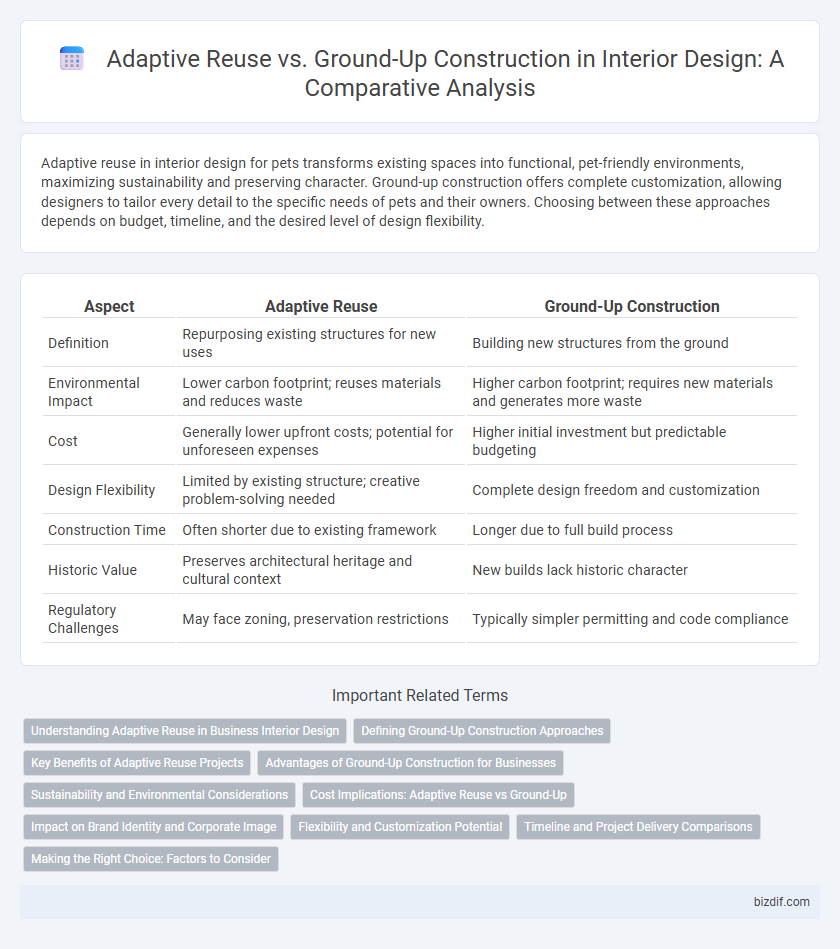Adaptive reuse in interior design for pets transforms existing spaces into functional, pet-friendly environments, maximizing sustainability and preserving character. Ground-up construction offers complete customization, allowing designers to tailor every detail to the specific needs of pets and their owners. Choosing between these approaches depends on budget, timeline, and the desired level of design flexibility.
Table of Comparison
| Aspect | Adaptive Reuse | Ground-Up Construction |
|---|---|---|
| Definition | Repurposing existing structures for new uses | Building new structures from the ground |
| Environmental Impact | Lower carbon footprint; reuses materials and reduces waste | Higher carbon footprint; requires new materials and generates more waste |
| Cost | Generally lower upfront costs; potential for unforeseen expenses | Higher initial investment but predictable budgeting |
| Design Flexibility | Limited by existing structure; creative problem-solving needed | Complete design freedom and customization |
| Construction Time | Often shorter due to existing framework | Longer due to full build process |
| Historic Value | Preserves architectural heritage and cultural context | New builds lack historic character |
| Regulatory Challenges | May face zoning, preservation restrictions | Typically simpler permitting and code compliance |
Understanding Adaptive Reuse in Business Interior Design
Adaptive reuse in business interior design involves transforming existing structures into functional workspaces, leveraging sustainability and cost-efficiency by minimizing demolition and construction waste. This approach preserves architectural character while accommodating modern office requirements, enhancing brand identity through unique space narratives. Compared to ground-up construction, adaptive reuse offers faster project timelines and reduced environmental impact, aligning with contemporary corporate social responsibility goals.
Defining Ground-Up Construction Approaches
Ground-up construction approaches involve building structures from the foundation upward, offering full design flexibility to meet specific functional and aesthetic requirements. This method enables the incorporation of advanced building technologies, sustainable materials, and customized layouts tailored to the intended purpose. Ground-up construction contrasts with adaptive reuse by allowing complete control over structural systems, spatial organization, and architectural style without constraints from existing frameworks.
Key Benefits of Adaptive Reuse Projects
Adaptive reuse projects significantly reduce construction waste and lower carbon emissions by repurposing existing structures instead of demolishing them. These projects preserve historic and architectural character, enhancing cultural value and community identity. Cost savings are often realized through reduced material expenses and faster regulatory approvals compared to ground-up construction.
Advantages of Ground-Up Construction for Businesses
Ground-up construction offers businesses the advantage of complete design flexibility, allowing tailored layouts and advanced infrastructure to meet specific operational needs. New builds incorporate the latest energy-efficient technologies and materials, resulting in long-term cost savings and sustainability benefits. This approach minimizes unforeseen renovation challenges, providing a predictable timeline and budget crucial for business planning and growth.
Sustainability and Environmental Considerations
Adaptive reuse significantly reduces environmental impact by repurposing existing structures, minimizing construction waste and preserving embodied energy compared to ground-up construction. Ground-up construction often requires extensive resource consumption, including raw materials and energy, leading to higher carbon emissions. Prioritizing adaptive reuse supports sustainable interior design practices by integrating eco-friendly materials and reducing the demand for new resource extraction.
Cost Implications: Adaptive Reuse vs Ground-Up
Adaptive reuse often reduces construction costs by utilizing existing structures, lowering expenses related to materials and labor compared to ground-up construction. Ground-up projects typically involve higher upfront investment due to site preparation and building from scratch, increasing costs for foundation work, permits, and infrastructure installation. Long-term financial outcomes depend on project scope, with adaptive reuse offering potential savings in renovation but possible hidden costs in retrofitting older buildings.
Impact on Brand Identity and Corporate Image
Adaptive reuse preserves historical elements and architectural character, reinforcing a brand's authenticity and sustainable values, which resonates strongly with eco-conscious consumers. Ground-up construction offers complete control over design, enabling a tailored brand environment that communicates innovation and modernity with clarity. Selecting between the two depends on how a company wants to position its corporate image--heritage and sustainability versus cutting-edge and custom-built identity.
Flexibility and Customization Potential
Adaptive reuse offers significant flexibility by integrating existing structures, allowing for creative customization within established frameworks and preserving architectural character. Ground-up construction provides maximum customization potential, enabling designers to create tailored spaces from the foundation up, unrestricted by prior building constraints. Both approaches demand strategic planning to optimize space utilization and meet client-specific functional and aesthetic goals.
Timeline and Project Delivery Comparisons
Adaptive reuse projects often have shorter timelines due to the preservation of existing structures, which can reduce both design and permitting phases compared to ground-up construction. Ground-up construction requires comprehensive site preparation, foundational work, and full architectural design, generally extending project delivery times significantly. Efficient timeline management in adaptive reuse leverages existing building frameworks, accelerating occupancy and minimizing delays typically encountered in new builds.
Making the Right Choice: Factors to Consider
Evaluating site conditions, budget constraints, and project timeline plays a crucial role in choosing between adaptive reuse and ground-up construction in interior design. Adaptive reuse leverages existing structures to preserve character and reduce environmental impact, while ground-up construction offers complete design flexibility and modern compliance. Understanding the intended function, sustainable goals, and regulatory requirements ensures the optimal decision for interior design projects.
Adaptive reuse vs Ground-up construction Infographic

 bizdif.com
bizdif.com